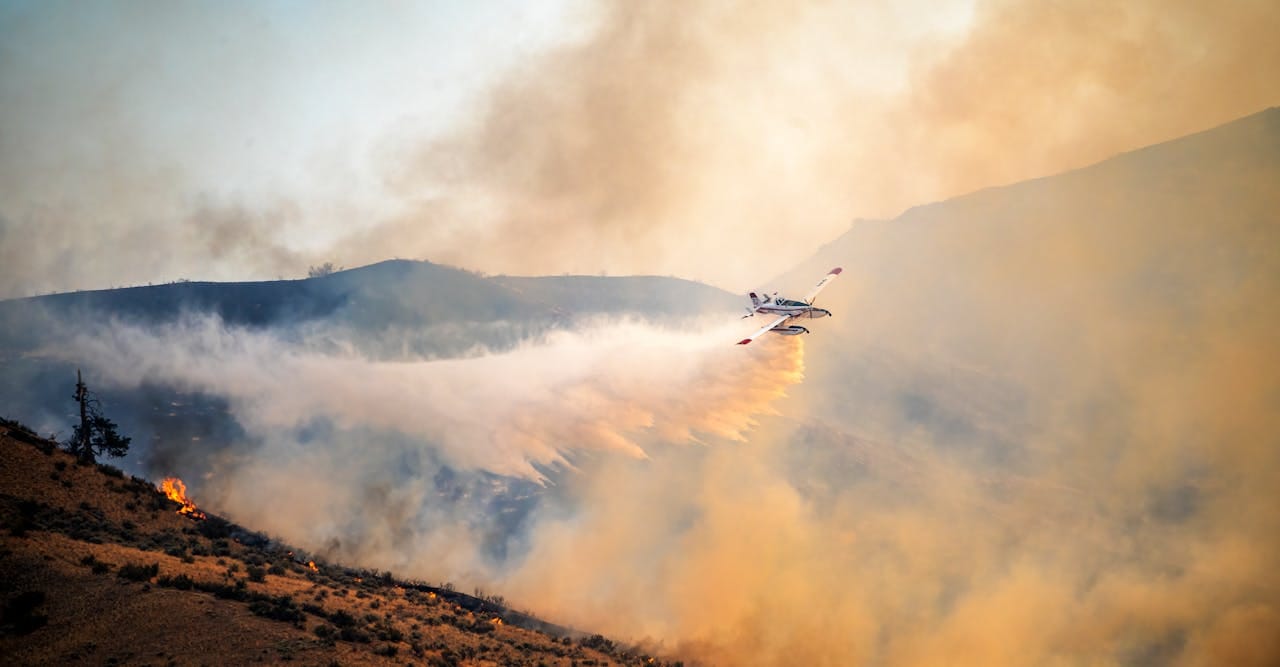
Where There’s Fire, There’s Smoke
By Ann Constantino,
Photo by Frank Cone.
Studies published over the past few years by the Yale School of Public Health, the journal Nature, and the journal Science all point to a growing number of premature deaths in Americans exposed to wildfire smoke. The studies also indicate that the combined effects of climate change with smoke inhalation will be especially damaging to populations vulnerable to excessive heat. The CDC estimates nearly 10,000 heat-related deaths have occurred since 2020.
Up to 40,000 premature deaths annually may be attributable to inhalation of wildfire smoke, more specifically particles known as PM2.5. These particles are smaller than 2.5 micrometers (a human hair is about 50 micrometers) and are capable of penetrating many vital parts of the human body via the lungs and bloodstream.
Small particles, massive consequences
The PM2.5 particles from wildfire smoke make up somewhere between 25 and 50 percent of PM2.5 pollutants from all sources, and as wildfires are predicted to rise in prevalence as climate change progresses, the effects measured over the past few years are expected to increase.
The Science study estimates that during the period of 2008 through 2018, upwards of 50,000 premature deaths could be blamed on wildfire smoke inhalation in California alone. The study states that PM2.5 from wildfire is 10 times more toxic than other PM2.5 found in the atmosphere.
Wildfire seasons are getting longer
As climate change makes the world hotter, wildfires are expected to get even bigger.
Wildfire “season” has already officially expanded, depending on the US region, from summer months of July through September to include spring and fall months, and in some places is considered a year-round health risk factor.
As climate change makes the world hotter, wildfires are expected to get even bigger and last longer. The exceptionally devastating effects of the ten million acres burned all across the west in 2020 could become the norm as soon as 2050, according to Minghao Qiu, climate and public health scientist at Stony Brook University, who co-authored the study published in Nature.
An expected rise in temperature through climate change will increasingly contribute to the drying out of vegetation, making it more flammable. This link between climate change and wildfire was a feature of all three reports, which also concluded that even should strong measures be undertaken right now to decrease fossil fuel emissions and mitigate temperature rise, wildfire incidence and its associated health concerns will increase nonetheless.
The human body under fire
In the study published by the Yale School of Public Health (YSPH), specific health issues resulting from PM2.5 exposure were revealed. Cardio-vascular diseases can occur or worsen as PM2.5 enters the respiratory tract and bloodstream, triggering oxidative stress and inflammation, leading to a variety of damage and disease. Kidney and endocrine system problems are second only to cardiovascular issues. The particle is also associated with insulin resistance and may be responsible for diabetes and other metabolic issues. When PM2.5 enters the digestive system, disruptions occur to the gut’s microbiome, resulting in digestive distress. PM2.5 can break the blood-brain barrier either via the bloodstream itself or through the olfactory system. Once in the brain, the pollutant may contribute to dementia or create vascular damage leading to stroke.
While toxic smoke inhalation is so far unlikely to appear on anyone’s death certificate, as the presence of wildfire smoke increases in our atmosphere and more research is carried out, that could change.
Additionally, research into the short and long-term health effects of toxic particles released into the atmosphere by the burning of non-organic materials, such as in residential and industrial buildings, remains to be carried out, but is expected to show worsening health outcomes and more complex concerns.
Preparing for a smokier future
Scientists are calling for education.
Many scientists contributing to these studies are urgently calling for a public health response to negative impacts of wildfire smoke inhalation. Studies show that particles travel many thousands of miles and are not just a local concern to inhabitants of fire-ravaged regions.
Vulnerable populations such as the elderly or those with serious comorbidities bear the greatest risk. Scientists are calling for education. N-95 or better masks when properly fitted and rotated can filter out PM2.5 but are not likely practical or affordable for the average citizen and can cause their own health issues when breathing is restricted by a well-sealed fit. It may be more pragmatic to install air filtration systems in homes and to establish clean-air centers in communities where citizens can get relief from especially dense layers of smoke.
While we here in SoHum have had a relatively mild smoke season, the particles from even distant fires, while not changing the color of the sky, are still likely delivering dangerous particles to our lungs. Given the dire predictions for the worsening of these conditions well into the future, now is the time to do all we can to optimize our current health and make a plan to have access to clean air in smoky conditions.
If you are heat sensitive or have comorbidities such as COPD, asthma, or cardio-vascular issues, see your provider for guidance.
Ann Constantino, submitted on behalf of the SoHum Health’s Outreach department.